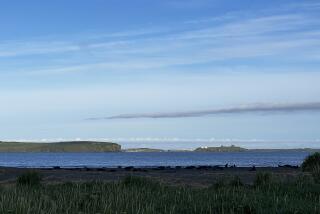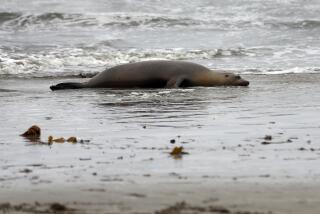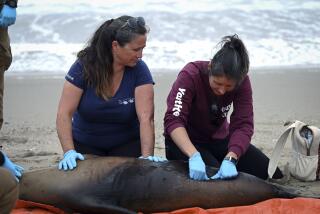Of Mice and Park Tourists
A medical and environmental mystery is unfolding offshore at Channel Islands National Park, where a succession of wet winters and a dearth of natural predators have caused a population explosion of disease-carrying mice.
Many of the mice--up to seven in 10 on Santa Cruz and Santa Rosa islands, two of the most popular tourist destinations in the five-island chain--are infected by hantavirus. That is the disease that in 1993 killed two dozen people in the Four Corners area where Utah, New Mexico, Arizona and Colorado meet.
“If you want to see deer mice, go to the Channel Islands. The concentration is so high you can almost step on them,” said Michael Ascher, chief of the state Department of Health Services virus lab in Berkeley and coauthor of a 1997 study on the matter. “There’s a ton of virus. It’s a pretty high risk. It’s [outbreaks] all set up to happen.”
But outbreaks have not occurred in the Channel Islands. Despite the fact more deer mice at Channel Islands are infected than anywhere else in the United States, none of the 60,000 tourists who visit the scenic islands each year has even become ill from hantavirus. Blood tests on a dozen park employees and longtime island dwellers four years ago showed no trace of the virus.
The National Park Service is so confident there is nothing to worry about that it has scaled back warnings to park visitors. Park service officials say they believe the type of hantavirus at the islands is not contagious to humans.
“This hantavirus is a strain that doesn’t infect human beings. Why else would no one get sick?” park Supt. Tim Setnicka said. “Even though there’s a high percentage of mice with hantavirus, there’s no potential for [disease] incidence. There’s no risk to the public or my employees. It’s a nonissue.”
The park service’s own documents, however, raise doubts on that.
Files obtained through the Freedom of Information Act refer to hantavirus at the park as “life-threatening” and “potentially fatal.”
A 1994 memo states, “We know that this virus has been fatal to humans and is present on the islands.”
Also, according to the state health department, the hantavirus common to deer mice at the islands is known as Sin Nombre, the same strain blamed for the outbreak in 1993.
Why is nobody getting sick? No one is quite sure. The only thing everyone agrees upon is that there are a lot of diseased mice running around the Channel Islands this year.
Park’s Mice Population Boomed After El Nino
Mice have always been abundant at the park, but these days the islands are literally crawling with the small creatures, which are about the same size as a field mouse. Mouse reproduction boomed after the drenching El Nino storms of 1997-98, which dumped 40 inches of rain on the islands, double the normal level. Thick mats of grass and spring flowers shot up, sowing a bounty of seeds in summer and fall for mice to gorge upon. An unseasonably mild winter this year favors the mice too.
National Park Service spokeswoman Holly Bundock said she spilled potato chips on a wooden patio one evening last year. The next day, she said, the mice had eaten the salt out of the wooden deck, leaving a groove in the wood, she said.
“There are thousands and thousands of them [mice]. They were always there, always moving, always running around, 24 hours a day. It drove people crazy,” she said.
On San Miguel Island, the numbers of mice have more than doubled to an average of 300 per acre, equivalent to 11 mice roaming the space of a modest single-family house. They concentrate near campgrounds and dwellings, studies have said.
“If you’re a camper, it can be a treat,” park biologist Gary Davis said. “They run right over your face when you’re in a sleeping bag. I guess that’s part of the island experience.”
The problem is so acute that mouse-proofing now figures prominently in the park service’s ongoing effort to upgrade ranger houses on the islands. New dwellings being built to replace the converted airport cargo boxes, drafty trailers and a 110-year-old adobe that rangers have been living in are being made as airtight as possible to keep mice out.
Deer mice are the only mouse species on four of the park’s five islands and the only rodent on Santa Barbara Island, which is one reason why they are so abundant. Birds of prey feed on the mice, but the rodents have few land-based predators. The tiny island fox, an imperiled species, has declined as much as 90% in the past six years on some islands, benefiting rodents, park biologist Tim Coonan said.
“We’re concerned about the mouse population,” Coonan said. “That number of mice unchecked for several years will eat more vegetation.” Mice are munching native sunflowers on Santa Barbara Island and threaten efforts to restore native plants denuded by decades of sheep and cattle grazing.
Hantavirus was first identified on the islands five years ago. But new concerns have arisen because the rodent population is surging at the same time the park is becoming an increasingly popular tourist destination, lying within easy reach of 15 million Southern Californians.
205 Cases Reported in U.S. Since 1993
Hantavirus has been detected in 28 states and typically occurs in 10% of mice, but 58% of the deer mice are infected on Santa Rosa Island alone, according to a recent study by the state health department.
People can be infected by breathing air contaminated by mice feces and urine, being bitten by a mouse or ingesting food or water contaminated by droppings. Hantavirus can cause a potentially fatal condition known as hantavirus pulmonary syndrome, which causes flu-like symptoms that eventually cause lungs to fill with fluid until the victim drowns.
Since 1993, 205 cases of hantavirus have been reported in humans in the United States, resulting in the deaths of 87 people. Twenty Californians have been infected, with nine fatalities.
Dr. Robert Levin, Ventura County’s health officer, said there is no cause for panic and he does not believe drastic action, such as mouse-eradication, is needed to protect people. He said, however, that stronger public notification is needed to warn people of the risk. “I’m sure we’ll have cases sometime in the future, maybe a few, maybe a lot. It’s bound to happen,” Levin said.
A few years ago campgrounds on all the islands were posted with hantavirus warnings and a fact sheet on the disease was available on counter tops inside the mainland visitors’ center in Ventura. Since then, efforts to inform the public on the situation have been scaled back.
There are no visible notices at the park’s mainland visitors’ center and no mention of it on the park’s Web page. The campground at Santa Cruz Island, which attracts the most visitors in the island chain, is not posted. Park brochures don’t mention it, though a bulletin park service officials say is sent to prospective campers does. But tourists who visit the islands say they have never heard about hantavirus.
Warnings on Virus Purposely Muted
Ted and Nancy Eyraud of West Los Angeles recently camped on Santa Cruz Island. They said they never heard of hantavirus on the islands, but wish they had been told. Mice, they said, had swarmed into the eucalyptus tree above their tent.
“It’s a big concern on the [Santa Cruz] island,” said naturalist Jacob Emmons, who escorts people to the park aboard charter boats. “I never hear the rangers talk about it. No one really talks about it. There’s a lot of concern that if you throw up the red flag, no one will come to the islands anymore.”
Setnicka, the park superintendent, acknowledges the warnings were purposely muted.
He said tourists have virtually no chance of becoming infected. “We toned down the warnings. Clearly no notice is necessary for a risk that is minimal or nonexistent. There’s no reason for change,” Setnicka said.
Conditions at Channel Islands National Park today are similar to those in 1993, when a major outbreak occurred in the Southwest. Heavy rainfall during the winter of 1991-92 produced an abundance of food and cover and an explosion of deer mice across the Southwest the following year, according to the Centers for Disease Control. Mice are at least 10 times more abundant and hantavirus twice as widespread at Channel Islands National Park as during the outbreak in the Four Corners region, studies say. Consequently, the CDC is urging people to pay special attention to preventive measures to reduce exposure to rodents.
At the outset of the current mouse population explosion, hantavirus, which doesn’t harm mice, is believed to have dipped because older animals had not yet spread it to juveniles. As age groups mingle, the disease tends to rip through the expanded population like wildfire, said James N. Mills, chief of the medical ecology unit in the special pathogens branch at the Centers for Disease Control.
That portends a bad year for hantavirus around the Southwest and at the Channel Islands. “It could mean you have high prevalence and high numbers of individuals that survive winter, which would represent a high risk to human populations,” Mills said.
Steps Taken to Reduce Infection Risk
Fatalities occurred a few years ago in Santa Barbara and in the Sierra Nevada, where a researcher working at the University of California Valentine Eastern Sierra Reserve near Mammoth became infected. Since that incident, UC field research stations reduce hantavirus risk through good housekeeping, including reducing trash around buildings, setting traps and warning people to avoid mice. Those practices are observed at the UC Santa Cruz Island Reserve at Channel Islands National Park.
“We’re not paranoid about this, but we ask people to take reasonable precautions,” reserve Director Lyndal Laughrin said. “Their [mice] populations explode more out here than on the mainland. There’s more public access. There’s more interaction and more public risk so that’s a concern. There’s no reason why they [visitors] shouldn’t be informed. It’s better to err on the conservative side and let people know what’s going on out here.”
But that does not always happen.
“What’s hantavirus?” asked Roberta Hodson of Massachusetts, as she returned from a January trip to the islands.
“I think they should tell people. That would be optimal. The public has a right to know,” said Nancy Eyraud, who camped on Santa Cruz Island in November.
Setnicka said hantavirus is too rare to rise to a level of significant concern for visitors.
“[There is] a much greater chance of getting burned on a campfire or falling off a cliff than getting hantavirus,” Setnicka said. “You have a much greater chance of getting injured in an auto accident than visiting a national park. You’ve got a greater chance of getting eaten by a great white shark at the islands. Looking at the real risk to the public, it’s not from hantavirus.”
*
’ You’ve got a greater chance of getting eaten by a great white shark at the islands. Looking at the real risk to the public, it’s not from hantavirus.’
Tim Setnika, Parks chief
(BEGIN TEXT OF INFOBOX / INFOGRAPHIC)
Hantavirus Found on the Channel Islands
The wet weather of recent years has spurred a population explosion of deer mice at Channel Islands National Park. Some health officials are concerned because many of the mice are infected with hantavirus, which can be transmitted to humans. Though an outbreak of the illness caused by the virus killed 24 people in the Southwest in 1993, so far no tourist has been infected. The park service believes this proves there is no danger. Though difficult to contract, people can get the virus from exposure to infected mouse droppings, urine or saliva.
How the virus is given to humans
1. Mouse droppings, urine and saliva containing the virus collect in areas where humans and mice coexist.
2. Particles containing the virus become airborne when disturbed.
3. Particles are inhaled and person becomes ill with the hantavirus pulmonary syndrome.
*
Clinical Symptoms
* Fever (usually ranging from 101 to 104 degrees and unresponsive to medication)
* Muscle and body aches
* Chills
* Dry cough
* Nausea, vomiting, diarrhea
* Fatigue
Symptoms usually last for a few hours to several days. The lungs then begin to fill with fluid, making breathing difficult. Shortness of breath is a major indication of problems. Anyone with these symptoms should seek medical care immediately.
*
Treatment
* Respiratory therapy
* Drugs that inhibit viral reproduction
* Routine hospital care
Precautions
* Avoid contact with mice
* Seal openings to keep mice out
* Keep pet food covered
* Wet floor before sweeping when rodent droppings are present
* Set mousetraps
*
Deer Mouse
Peromyscus maniculatus
* Identification: Head and body 2 to 4 inches; tail 2 to 5 inches. Color ranges from pale gray to deep reddish brown. Tail always sharply bicolored, white below, dark above.
* Habitat: Nearly every dry-land habitat within its range is occupied by this species.
* Habits: Nests in burrows in ground, in trees, stumps and buildings. Feeds on seeds, nuts, acorns, insects; stores food.
Source: Centers for Disease Control and Prevention; California Department of Health Services
More to Read
Sign up for The Wild
We’ll help you find the best places to hike, bike and run, as well as the perfect silent spots for meditation and yoga.
You may occasionally receive promotional content from the Los Angeles Times.






